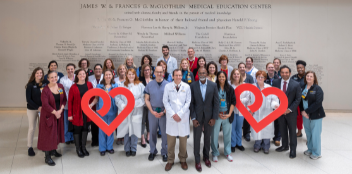Two New Cath Labs Unveiled
In March, two more labs opened their doors as part of a $24 million renovation that VCU Pauley Heart Center began in 2013.
“They’re state-of-the-art labs aimed at providing the best quality imaging that’s available for both diagnosis and interventions,” says Dr. George Vetrovec, director of VCU’s Adult Cardiac Catheterization Laboratory. The improved imaging enhances the safety of routine procedures, while also allowing the heart center to treat more high-risk patients in a cath lab setting, he says.
In the large, uncluttered labs, stainless steel cabinets hide supplies, and much of the equipment is mounted on ceiling booms—meaning, no power cords to trip over. Large flat-screen monitors hover near operating tables. Physicians can view, on multiple split screens, patient vitals, past scans, images from other diagnostic equipment and real-time fluoroscopy—all supported by monitors in an adjoining control room. The equipment and the room design reduce patient and staff radiation exposure to the lowest levels possible while providing exceptional images.

On the floors, pathways in different colors show where the equipment will move during a procedure. The paths are helpful to team members. “It tells them right away where they can safely stand,” says Ruth Williams, RN, nurse manager, Invasive Cardiology, Electrophysiology and Cardiovascular Procedural Care Unit.
The new environment combines the amenities of a cardiac catheterization lab with the sterile environment of an operating room—allowing for more complex invasive interventions. Cath 1 is designed for the pediatric population with bright colors on the walls and other amenities. In the room, doctors can also perform diagnostic and interventional procedures in the peripheral veins and arteries of the body.
“Before, when we had patients with blockages in their legs, we really didn’t have optimal facilities in the cath lab to work with them. They had to have surgical interventions,” says Dr. Kenneth Ellenbogen, chair, VCU Division of Cardiology.
“Cath 2” includes an Innova IGS 520 system and Corindus Vascular Robotics, used for percutaneous cardiac interventions and the positioning of stents.
“Cath 3” and “Cath 4” are now undergoing renovations. Cath 4 will be a “hybrid” room featuring the Discovery IGS 630 system, which has a gantry with flexible positioning that is ideal for conducting procedures for structural heart disease. It also allows doctors to immediately convert from minimally invasive to open-heart procedures if necessary.
The heart center opened the first new lab in September 2013. When the entire project is completed, the Pauley Heart Center will have seven state-of-the-art GE labs to meet the increasing needs of its patients and enhance its ability to conduct new procedures in the long term.
As for research, “the labs will give us more tools to understand the physiology of the heart and will lead to more discoveries,” says Dr. Ellenbogen.
Back to Spring-2015
Join our Pauley Consortium composed of patients, friends and advocates.

